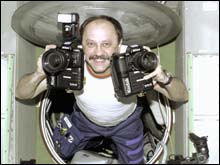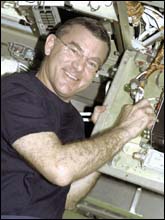|
Space: final ad frontier
|
 |
May 2, 2001: 4:02 p.m. ET
RadioShack will use space station and Russians to hawk its Father's Day gift
By Staff Writer Chris Isidore
|
NEW YORK (CNNfn) - A Russian cosmonaut is about to go where no U.S. astronaut has ever gone before: onto a U.S. television commercial.
RadioShack is preparing to film Yuri Usachev receiving a talking picture frame from his daughter as a Father's Day present, in a commercial touting the frames. RadioShack then plans a saturation media campaign for the spot for the two weeks before the holiday to push the frame.

|
|
|
Russian cosmonaut Yuri Usachev is to be seen in the first U.S. commercial filmed in space, a spot planned by RadioShack. (Source: NASA) | |
The company also sent one of the frames to U.S. astronaut James Voss, who along with Usachev and Susan Helms has been aboard the International Space Station since March. Both frames include 10-second recorded greetings from the men's daughters.
But NASA's code of conduct for its astronauts prohibits them from appearing in a commercial or being seen as endorsing a product or business venture from space. So while RadioShack is still seeking permission to include shots of Voss in the commercial, officials with the electronics retailer aren't hopeful.
"We'd love to have both in there, but I don't think it's diminished by having only Yuri," said Jim McDonald, senior vice president of marketing and advertising for RadioShack. "What you want to capture is emotion of surprise, of a human being reacting with delight, to this kind of connection between a father and daughter. It doesn't matter if he's Russian or American."
He said that Usachev knows there will be a U.S. company filming him receiving a gift from Earth, but he doesn't know what it is.
Russians have pitched from space before
There were commercials for Tnuva, an Israeli milk, as well as for Pepsi filmed aboard the former Russian space station Mir. But the 1996 Pepsi spot was only shown in overseas markets, such as Russia, to advertise a new design for the soft drink's can in those countries. This RadioShack spot is believed to be the first U.S. ad to be filmed in outer space.
| |

|
|
U.S. astronaut James Voss is due to receive the same type of talking picture frame as his Russian colleague, but NASA policy will apparently stop him from appearing in the RadioShack spot. (Source: NASA) | |
McDonald said the commercial will be filmed by one of the cosmonauts who brought the frames and a special camera with him on Saturday's Soyuz flight, the same flight that delivered Dennis Tito, the first paying tourist to visit outer space, to the International Space Station. The film will be brought back to Earth next week, rather than using the somewhat grainy video feed from the station for the commercial.
Usachev is actually a veteran of both of those earlier commercials, but the world's first zero-gravity pitchman is not getting a specific payment for appearing in the commercial, according to McDonald.
McDonald said there was a payment made to the Russian space agency, but he would not say for how much, other than to say it is "not a huge sum," and well less than the $20 million that Tito paid the Russians to be the first tourist in space.
Russians seek dollars U.S. shuns
One of the Americans involved in negotiations for the commercials says it is ironic that the formerly communist Russian space program is more open to these kinds of commercial ventures than is the U.S. space program.
"The Russians are capitalists. The American can not be. That seems to be the socialist approach of NASA," said Jeffery Manber, president of Mir Corp., a corporation seeking commercial use of outer space through Russia's space vehicles and other assets. "Space is going to be a tremendously fertile market for advertising. I hope NASA learns to accept it's a terrific way to excite the public."
Manber said that the Russians are open to the commercial ventures because they so desperately need money to keep their program going.
"The Russians need funds to go into their production line," Manber said. "The budget of the Russian program is about $170 million a year. NASA's budget is $13 billion. This is a drop in the bucket, but the Tito money is essential for the next Soyuz flight in October. They're going from Soyuz to Soyuz with nontraditional sources of money."
Officials with NASA, who strongly objected to Tito's trip to the ISS aboard the Soyuz, said it did not have the same objections to filming commercials, but its current rules did not permit it to participate.
"If they want to do commercials on board the Russian segment, that's up to them," said Debra Rahn, spokeswoman for international affairs for NASA. "I know we're looking at a whole range of how best to commercialize the International Space Station. But we've never been permitted to do commercials."
Not a one-time effort for RadioShack
These commercials aren't the only times that the Russian's space program have helped to publicize U.S. consumer brands. One of the Russian rockets that carried a part of the space station last July had the Pizza Hut logo on it.
Click here for a look at retail stocks
This isn't the only effort by RadioShack to tie its name to outer space exploration, either. It is the first sponsor of LunaCorp, a private-held company that is seeking to have an unmanned robotic probe become the first moon landing since Apollo, as it searches for signs of water there. RadioShack's logo will be prominently displayed on the landing craft and rover.
LunaCorp also helped arrange for the picture frames on the space station.

|
|
|
Pizza Hut paid the Russian space agency to put the company's logo on the side of one its rockets when it was launched last July. (Source: Pizza Hut) | |
McDonald said RadioShack has looked at a number of other advertising opportunities in the past, including a potential live Super Bowl spot from the Mir when it was still in orbit. This is just the first one that worked out.
He said that even though interest in outer space isn't as great as it once was, it's a good venue for selling some of its key products, such as wireless phones and satellite television systems, as well as broadband communications.
"Our efforts makes more sense than someone selling pizza looking for name recognition," he said. "We sell more wireless phones than anyone. And there's still tremendous interest in space, even if it's not at the minute to minute level it was during Apollo. I think clearly the Tito flight got an unusually great amount of attention because it focused people's thinking on making a space trip themselves some day. But we would have done this commercial whether or not Tito had gone up." 
|
|
|
|
|
 |

|

